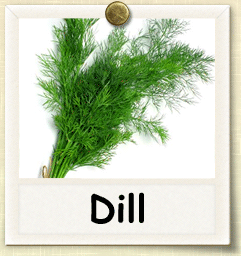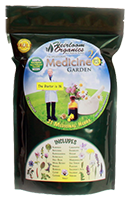|
Home > Guides > Herbs > Dill |
|
How to Grow Dill | Guide to Growing Dill |
|
|
|
|
| |
 |
|
Overview |
|
|
|
|
|
| |
|
| |
Pickles, salad dressing, seafood, potatoes, and cucumbers: these are just a few of dill’s culinary dance partners, making it a favorite in the herb garden. It's flavor is never better than when you pick it fresh from your garden. Another good reason to grow this graceful plant: The umbel of delicate yellow-green flowers attracts beneficial insects, from pest-eating wasps to colorful butterflies. |
|
| |
|
|
| |
Growing Guide
GROWING NOTES
MAINTAINING
Common dill grows to a height of about 3 feet; bouquet dill is a smaller variety that generally produces fewer blossoms and seeds. Dill produces a strong taproot like its cousin the carrot, and so does poorly when transplanted. Instead sow seed right in the garden. Plants thrive in rich, loose soil and full sun location. If you hope to harvest seed at pickling time, plant 1 to 2 weeks before the last spring frost date. In plots that receive less than 6 hours of direct sun per day, grow stocky varieties, such as ‘Delikat’ or ‘Fernleaf’.
Sow Seed 1/4 inch deep in rows 18 to 24 inches apart or broadcast over a bed 2 feet square and gently rake the seeds into the soil. Plants should emerge in 10 to 14 days; let them grow for 10 to 14 more days and then thin them to 12 to 18 inches apart. Make small sowings a few weeks apart until midsummer to get a season-long supply of fresh leaves.
If your garden is in a windy spot, stake the tall plants to prevent wind damage, or grow a dwarf variety. If you let a few plants mature and drop seed, and leave the area undisturbed, seedlings will emerge the following growing season.
Dill in home gardens rarely has pest or disease problems, but black swallowtail butterfly larvae depend on dill as a food source. If they show up in your garden, you can concentrate the caterpillars on a few plants, and reap a double bounty — dill and butterflies!
|
|
| |
|
| |
Heirloom seeds are the gardeners choice for seed-saving from year-to-year. Learning to save seeds is easy and fun with these books. Before you harvest, consider which varieties you might want to save seeds from so that your harvesting practice includes plants chosen for seed saving. Be sure to check out our newest seed packs, available now from Heirloom Organics. The Super Food Garden is the most nutrient dense garden you can build and everything you need is right here in one pack. The Genesis Garden s a very popular Bible Garden collection. The Three Sisters Garden was the first example of companion planting in Native American culture. See all of our brand-new seed pack offerings in our store.
|
|
| |
|
|
| |
Harvesting Guide
HARVESTING
You can start harvesting the fern-like leaves about 8 weeks after planting. Just pinch off the outer leaves close to the stem. They are most flavorful just when flower heads are opening.
Spread leaves on a screen in a cool, dark place to dry. If you freeze the dried leaves in plastic bags with the air pressed out, they will retain their flavor better.
To harvest seed for pickling, cut off the seedheads when they're light brown, dry them for a few days in paper bags with air holes in the sides, then shake seeds loose in the bag. To separate the seed from the chaff, spread a sheet out on the grass, set a portable fan at one edge of the sheet facing the center, and turn it to "low". Pour the collected seed in front of the fan's breeze, and it will blow away the light chaff, allowing the heavier seed to collect on the sheet below. Store dill seed as you would dried leaves.
SAVING SEEDS
Knowing how to save dill seeds is crucial, no matter what you’re planning on using them for. The best dill seeds come from the late-blooming plants, which usually bloom in late summer. Preserving dill seeds is incredibly easy, so you can add their delicious flavor to food whenever you’d like. There are several easy at-home preservation methods that will work well and keep your dill fresh for years.
Jar Preservation
If you’re saving your dill seeds for flavor, you should keep them in pickle vinegar and wait for the seeds to mature and turn brown. This is when the seeds are the most flavorful and they will become more flavorful the longer they stay in the vinegar.
The best storage method for dill seeds is placing them in a clear, air-tight jar. The jar should be sealed with tape around the lid and kept in a dark, cool location, such as a basement. They can be stored safely for several years, but should be checked periodically to ensure a tight seal.
Freezing
Keeping the dill attached to the stalk, rinse it in cool water and let it dry on a paper towel. Once it’s dry, put it in a clear, plastic storage bag and seal it tight. Gaps in the seal can result in freezer-burned dill, which causes the plant to lose freshness.
Drying
Drying out dill is perfect for people who wish to use it on food. Place the dill under cool water to rinse it and then allow it to air dry on a paper towel. Place the parts of the plant that you wish to preserve (you can preserve the flowers and leaves in addition to the seeds) in a food dehydrator. Following the directions for drying herbs, keep the dill in the dehydrator for the allotted time and then store it in a vacuum-sealed bag.
|
|
| |
|
|
|
| |
|
|
|
|
|
| You can find this variety in the following Seed Packs: |
|
 |
|
| Click the packs below to see some of our other wonderful products |
|
|
|
|
|
|
|